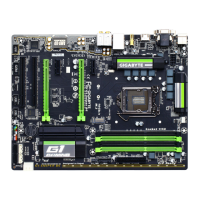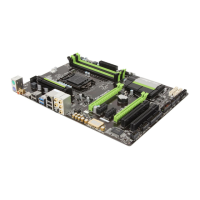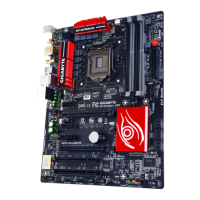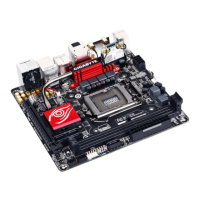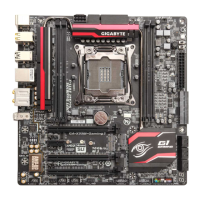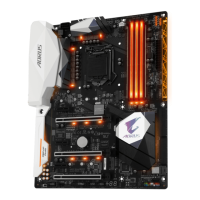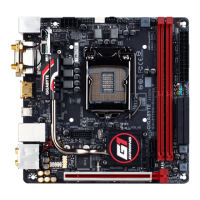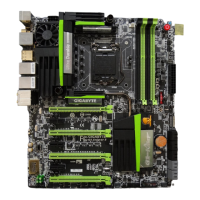
Do you have a question about the Gigabyte G1.Sniper 5 and is the answer not in the manual?
| ECC | No |
|---|---|
| Non-ECC | Yes |
| Memory voltage | 1.5 V |
| Memory channels | Dual-channel |
| Memory slots type | DIMM |
| Number of memory slots | 4 |
| Supported memory types | DDR3-SDRAM |
| Maximum internal memory | 32 GB |
| Supported memory clock speeds | 1333, 1600, 3000 MHz |
| Processor manufacturer | Intel |
| Compatible processor series | Intel Celeron, Intel Pentium |
| Supported processor sockets | LGA 1150 (Socket H3) |
| Maximum number of SMP processors | 1 |
| USB 2.0 connectors | 2 |
| Number of SATA III connectors | 10 |
| Number of Parallel ATA connectors | 0 |
| HDMI version | 1.4a |
| Headphone outputs | 5 |
| USB 2.0 ports quantity | USB 2.0 ports have a data transmission speed of 480 Mbps, and are backwards compatible with USB 1.1 ports. You can connect all kinds of peripheral devices to them. |
| USB 3.2 Gen 1 (3.1 Gen 1) Type-A ports quantity | 6 |
| Cooling type | Active |
| Component for | PC |
| Power source type | ATX |
| Motherboard chipset | Intel® Z87 |
| PC health monitoring | CPU, FAN, Temperature |
| Audio output channels | 5.1 channels |
| Motherboard form factor | Extended ATX |
| RAID levels | 0, 1, 5, 10 |
| Supported storage drive interfaces | SATA, SATA II, SATA III |
| Graphics card | HD Graphics |
| Maximum resolution | 4096 x 2160 pixels |
| Parallel processing technology support | 2-Way CrossFireX, 2-Way SLI, 3-Way CrossFireX, 3-Way SLI, 4-Way CrossFireX, 4-Way SLI |
| PCI Express x1 slots | 3 |
| PCI Express slots version | 2.0, 3.0 |
| PCI Express configurations | 2x8, 2x16 |
| Cables included | SATA |
| Wi-Fi standards | 802.11a, 802.11b, 802.11g |
| Bluetooth version | 4.0 |
| Ethernet interface type | Gigabit Ethernet |
| BIOS type | EFI AMI |
| ACPI version | 2.0a |
| BIOS memory size | 16 Mbit |
| Depth | 264 mm |
|---|---|
| Width | 305 mm |
Guidelines to prevent damage to the motherboard and components during installation.
Details the technical specifications of the motherboard and its components.
Step-by-step guide for installing the CPU and its cooling solution.
Instructions for installing RAM modules, including dual-channel configuration.
Procedure for installing add-in cards into PCI Express slots.
Guide for configuring multi-GPU setups for enhanced graphics performance.
Description and function of ports located on the motherboard's rear panel.
Explanation of motherboard's integrated buttons, switches, and indicator lights.
Procedure for replacing the operational amplifier IC on the motherboard.
Identification and function of various internal headers and connectors on the motherboard.
Overview of the initial screen displayed when the computer boots.
Introduction to the BIOS interface modes (Windows/Classic) and navigation.
Settings for monitoring and adjusting CPU, memory, and voltage parameters.
Configuration for system language, date, time, and access level.
Settings related to boot options, security, and system startup behavior.
Configuration options for onboard devices like graphics, LAN, audio, and USB.
Settings for controlling system power states and energy saving features.
Options for saving BIOS changes, loading defaults, and exiting the setup.
Guide for setting up SATA controllers and RAID configurations with Intel Z87.
Instructions for configuring Marvell SATA controller and RAID options.
Steps for installing necessary drivers and OS after SATA/RAID configuration.
Process for installing essential chipset drivers from the provided disk.
Information on installing bundled GIGABYTE applications and utilities.
Details on drivers and contact information for GIGABYTE Taiwan.
Overview of GIGABYTE's BIOS update tools: Q-Flash and @BIOS.
Introduction to the GIGABYTE App Center for managing system applications.
Guide to using EasyTune for system tuning, overclocking, and fan control.
Overview of EZ Setup utilities for simplified system configuration.
Functionality for charging mobile devices via USB, even when the system is off.
Utility to block specific types of USB devices on the PC.
Configuration and monitoring of network connection status and bandwidth.
Setup for 2/5.1-channel audio configurations and creative software suite.
FAQs and procedures to diagnose and resolve common system startup issues.
Table of POST codes and their descriptions for diagnosing boot issues.



